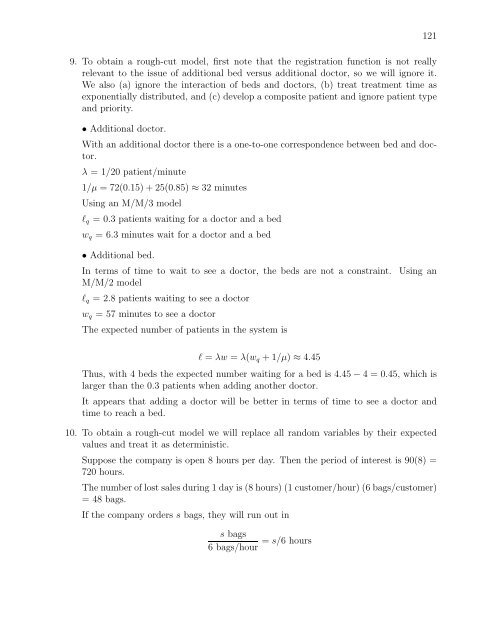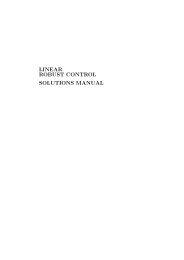SOLUTIONS MANUAL for Stochastic Modeling: Analysis and ...
SOLUTIONS MANUAL for Stochastic Modeling: Analysis and ...
SOLUTIONS MANUAL for Stochastic Modeling: Analysis and ...
Create successful ePaper yourself
Turn your PDF publications into a flip-book with our unique Google optimized e-Paper software.
9. To obtain a rough-cut model, first note that the registration function is not really<br />
relevant to the issue of additional bed versus additional doctor, so we will ignore it.<br />
We also (a) ignore the interaction of beds <strong>and</strong> doctors, (b) treat treatment time as<br />
exponentially distributed, <strong>and</strong> (c) develop a composite patient <strong>and</strong> ignore patient type<br />
<strong>and</strong> priority.<br />
• Additional doctor.<br />
With an additional doctor there is a one-to-one correspondence between bed <strong>and</strong> doctor.<br />
λ = 1/20 patient/minute<br />
1/µ = 72(0.15) + 25(0.85) ≈ 32 minutes<br />
Using an M/M/3 model<br />
l q = 0.3 patients waiting <strong>for</strong> a doctor <strong>and</strong> a bed<br />
w q = 6.3 minutes wait <strong>for</strong> a doctor <strong>and</strong> a bed<br />
121<br />
• Additional bed.<br />
In terms of time to wait to see a doctor, the beds are not a constraint.<br />
M/M/2 model<br />
l q = 2.8 patients waiting to see a doctor<br />
w q = 57 minutes to see a doctor<br />
The expected number of patients in the system is<br />
Using an<br />
l = λw = λ(w q +1/µ) ≈ 4.45<br />
Thus, with 4 beds the expected number waiting <strong>for</strong> a bed is 4.45 − 4=0.45, which is<br />
larger than the 0.3 patients when adding another doctor.<br />
It appears that adding a doctor will be better in terms of time to see a doctor <strong>and</strong><br />
time to reach a bed.<br />
10. To obtain a rough-cut model we will replace all r<strong>and</strong>om variables by their expected<br />
values <strong>and</strong> treat it as deterministic.<br />
Suppose the company is open 8 hours per day. Then the period of interest is 90(8) =<br />
720 hours.<br />
The number of lost sales during 1 day is (8 hours) (1 customer/hour) (6 bags/customer)<br />
= 48 bags.<br />
If the company orders s bags, they will run out in<br />
s bags<br />
= s/6 hours<br />
6 bags/hour















